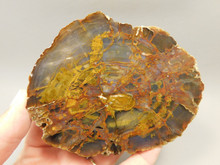Petrified Wood may retain the details of the original wood, but often the bright colors are not common in the actual wood and are what makes Petrified Wood so beautiful. So where do those beautiful colors in Petrified Wood come from?
The colors in Petrified Wood come from the minerals that were present during its replacement process. Here is a list of the colors of Petrified Wood and what minerals produce them:
Brown- so how come so much of petrified wood is brown if color is not something preserved from the original wood? Brown is most likely caused from residual organic material and maybe from iron. Tan indicates silica dioxide was present and it is the most common color in petrified wood.
Black- remnant carbon can produce from dark colors to black petrified wood. Manganese can also cause dark colors like browns, dark grays, and black. Black is often found in petrified wood from Arizona, Nevada, Oregon, and Utah.
Blue- is caused by manganese dioxide, cobalt or copper. Found in petrified wood from Arizona, Washington, and of course the lovely Eden Valley wood in Wyoming.
Green- can be caused by ferrous iron, chromium, copper, cobalt, nickel, and perhaps vanadium.
Lavender- traditionally attributed to traces of manganese oxides, but more recently believed to be iron.
Pink and Purple- ferric acid or iron oxide can produce many shades of red, including pinks and purples. Purple can also be caused by manganese dioxide. Pink and Purple are rarer colors, but still found in petrified wood from Arizona, Oregon and the famous Texas Springs, Nevada limb cast!
Red- is caused by iron (hematite) or manganese. Very common in the Rainbow Arizona Wood, and also found in petrified wood from Madagascar, California and Nevada.
White and Clear (colorless)- this usually occurs when there were no impurities present, just pure silica. White and clear are more common in petrified woods from Colorado, Nevada, Montana, and Washington.
Yellow and Orange- ferric acid or iron oxide (goethite) produce many shades of yellow, orange, red, brown and black. Also, manganese can produce yellow. Bright yellows are found in petrified woods from Arizona, California, Oregon and Washington.
If you missed last month’s blog here it is:
It was the first of a monthly series of blogs I’m writing on Petrified Wood and explains what petrified wood is and how it is formed.
Check back in the next few months as I plan to explore specific locations of petrified wood and more of the petrified wood oddities-such as insects, fungus, limb cast, etc.
 US Dollar
US Dollar
 Australian Dollar
Australian Dollar
 Euro
Euro
 CAD
CAD

